#Rich History of Black American Cowboys
Explore tagged Tumblr posts
Text
Meet a New Generation of Black American ‘Cowboys’
With these images, photographer Kennedi Carter smashes an age-old stereotype: Cowboys aren’t all white men on horses, battling Indigenous people.
— Story and Photographs By Kennedi Carter | July 18, 2023

Doniyel Hooker bought her horse, Chance, in 2018. Whenever possible, Hooker, a math and science teacher, brings Chance to her elementary school to provide new experiences for her students. She’s ridden Chance on trails and even through the French Quarter of New Orleans.
The first time I saw a Black horseman, I was maybe six years old. I’m 24 now, grew up in the suburbs of Durham, North Carolina, but my mother’s family is from Dallas, and we’d drive back to visit. I remember this as one of those things where you’re chilling in the back seat, you see something crazy, your head does a complete 180. Cowboys! The white-man-on-a-horse archetype; battles with Indigenous people: That’s what I was most familiar with, from going to the movies with my grandfathers. So about five years ago, as I began to photograph on film, I thought it would be very interesting to turn that cowboy narrative inside out a bit. It’s always important to expand the narrow confines of what we perceive to be American culture, and how we as Black people sit inside it.
I’ve had a whirlpool of feelings, being a witness to these people. There’s a rich history of Black American cowboys, but for my work I’ve used the word “equestrian”—more inclusive now, I think. For a long time I observed from the ground, asking equestrians whether I could photograph them; I’d never ridden a horse myself until I climbed onto one while visiting trainer Silas Plummer outside New Orleans. Did I feel fully comfortable or at home? No. I thought a lot about not falling off. But in the Louisiana town where my grandfather was born, his sharecropper family didn’t have cars, so one assumes they were using horses or mules to get around. That was beautiful to circle back to, very ancestral.
And my biggest takeaway, working with all the equestrians, is just how alive they feel when they’re on a horse. There’s a freedom that comes from interacting with animals, with nature, with the land. This is what one form of that freedom looks like.
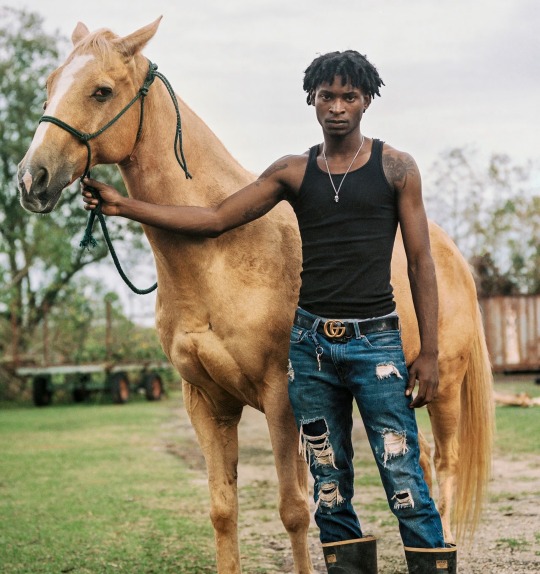
Horse trainer Silas Plummer holds Kash outside Child’s Arena stables in Bridge City, Louisiana. From wranglers to rodeo riders to jockeys, Black men and women have made their mark in many areas of horsemanship. In the United States, for example, an estimated one in four cowboys in the late 19th century was Black.
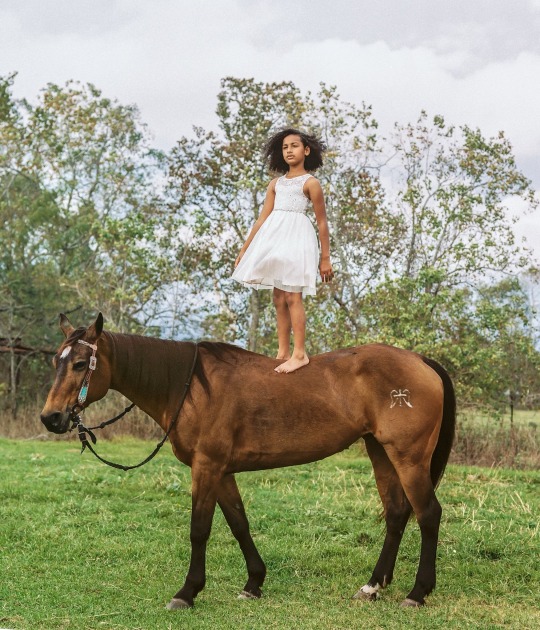
MaLana Lewis first rode a horse at age five during a camping trip. Her family later got her into barrel racing classes, and she has collected 24 first-place ribbons with her horse, Star. This photograph was taken in 2020, when Lewis was nine.

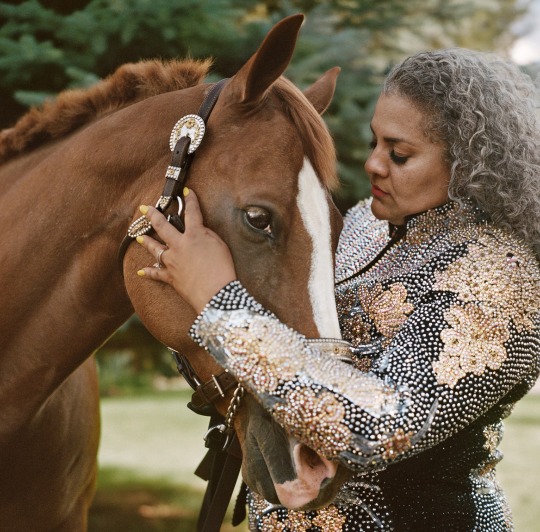
Left: Born to formerly enslaved parents in Texas, Bill Pickett became the best known Black rodeo star at the turn of the 20th century. He created the sport of bulldogging, or steer wrestling. Pickett performed around the world and was the first Black man inducted into the National Rodeo Hall of Fame. Courtesy North Fort Worth Historical Society
Right: After barrel racing as a teen, Esperanza Tervalon now trains with JaxieBaby in Bend, Oregon, to “go low and slow” in western pleasure riding competitions. The political consultant turns to horses to bring peace to her life. “I get centered. I always leave the barn feeling better than when I walked in.” Photograph By Kennedi Carter
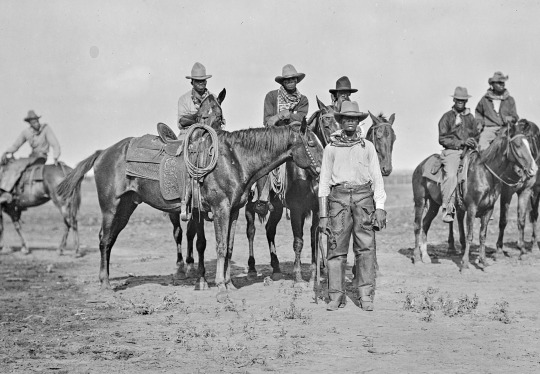
In the early 1900s, Black communities held festivals and rodeos in cattle country across various southern states. Here a group of cowhands show off their steeds at the Negro State Fair on the Fannin County Fairgrounds north of Bonham, Texas, in 1911. The annual event involved four days of parades, music, and rodeos. Racers also competed for prizes of $2 to $50. Courtesy of Erwin E. Smith Collection of The Library of Congress On Deposit at Amon Carter Museum of American Art, Fort Worth, Texas
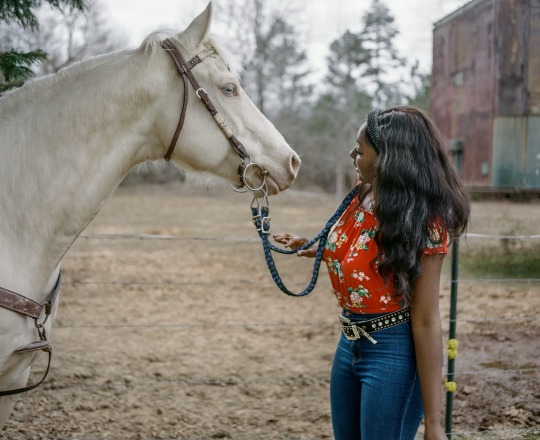
Trigger was Vinsha Torain’s first horse, and the two have ridden together since the college student was 13. Torain helps run the family ranch, started by her grandfather, in Siler City, North Carolina, and also heads Torain Ranch’s riding club, composed mainly of Black women.


Left: Nat Love, also known as Deadwood Dick, was born into slavery on a Tennessee plantation in 1854. After the Civil War he moved west and spent 20 years driving cattle. He got his nickname in Deadwood, South Dakota, after beating out every other competitor in roping and shooting contests.
Right: Isom Dart, born into slavery as Ned Huddleston in 1849 in Arkansas, was killed in 1900 in Colorado by a bounty hunter. A jack of many trades, including cook, miner, stunt rider, and horse and cattle thief, he was, ironically, shot for suspected cattle rustling once he’d gone straight. Courtesy Denver Public Library, Western History Collection
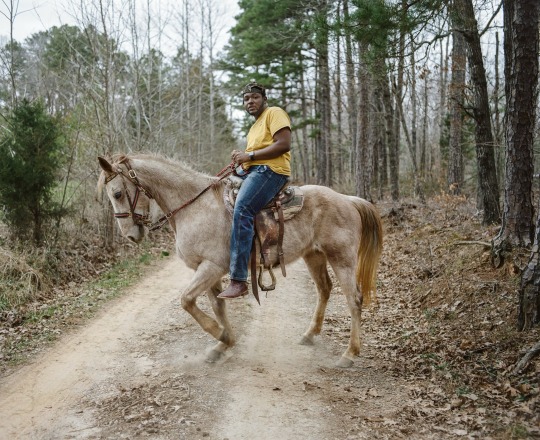
Jamel Robinson puts a client’s horse through exercises on a trail in Siler City. He started riding when he was four and training horses when he was 17. Robinson plans to stay in the business, which he learned from his father. “Horses keep me in a good mind space,” he says.
18 notes
·
View notes
Text
Black American Cowboy & Rodeo Culture in Arizona
"Since it first began in 2011, the Arizona Black Rodeo has become one of the biggest and most renowned Black American cultural and educational gatherings in the Grand Canyon State. The event celebrates the rich history and contributions of Black cowboys and cowgirls. It seeks to preserve this often-overlooked part of American history while providing a thrilling and family-friendly experience. Here, participants compete and shed light on the significant role Black Americans have played in shaping the heritage of the Southwest.
"Over 100 cowboys and cowgirls participate, hailing from Arizona, Arkansas, Oklahoma, Texas, New Mexico and California. The Arizona Black rodeo commences with the performance of the Black National Anthem, followed by grand entry celebrations and a tribute to the Buffalo Soldiers. Some of the main attractions of the Arizona Black Rodeo include bull riding, steer wrestling, saddle bronc and bareback riding, and barrel racing." (x)
youtube
Black American cowboy and rodeo culture is a long-standing tradition dating back to the 1800s. They even had a 4-year-old cowgirl out there this year ❤️
#black american culture#black cowboys#black cowgirls#rodeo culture#black rodeo#arizona black rodeo#tevin campbell
185 notes
·
View notes
Text
Quick little one-off thing- but I’m honestly so like… confused with honkai Star rail and making penacony the planet of “how many cultures can we steal”
Lowkey rant below
Like penacony itself is based around the jazz age which was made by African Americans, and their culture- but there’s not a SINGLE black playable character. Like girl. Really?
Like you got Boothill who’s supposed to be native and Hispanic and looks like a white guy from Nevada named John. While being a cowboy, which has a whole history and stuff- but basically dude should not be white, especially because on top of that his planet, and his story is based around the Native American genocide, and paints the pic to be very similar to Britain/ America.
Aventurine is supposed to be Roma/Romani but he looks like every twink I see at the mall in my town, like he has NOTHING to represent his culture.
And now Rappa- who while I think she might be a gag character meant to poke fun at weebs, she makes me nervous too- because like. Dude. Hyv is gonna pull some shit like “she’s a gangster!!” And give her like weird stereotypes while making her a Japanese girl. Like those white people who are like “I live in the ghetto” but are literally rich and own 4 boats, a lake house, and have a fat fucking family, and a mansion. Like. I’m really nervous that they’re gonna make her use aave and just… misuse it so bad… like they had an instance of that in zzz- I believe, but maybe they used it right. I can’t remember, but it was in one of Zhu yuan’s like hang out things- and some girl said something but I can’t remember what exactly it was and if they used it right or not. Either way, I’m really worried that Rappa will just be a big fuck up because her design is cool, even though she’s another instance of a design I think would look better if she was black, or just dark skinned.
#cal chats#boycott hyv#hyv boycott#hoyoverse#hoyoverse boycott#boycott hoyoverse#HYVboycott#honkai star rail#honkai sr#honkai rappa#rappa#Boothill#honkai Boothill#honkai aventurine#aventurine#penacony
39 notes
·
View notes
Text

LETTERS FROM AN AMERICAN
June 25, 2024
HEATHER COX RICHARDSON
JUN 26, 2024
These days, reality is undermining the political power of the mythological image of the American cowboy. In the years after World War II, that image helped to sell the idea that a government that regulated business, provided a basic safety net, promoted infrastructure, and protected civil rights for Black and Brown Americans and for women was cruising perilously close to communism. The cowboy image suggested that a true American was an individualist man who worked hard to provide for and to protect his homebound wife and children, with a gun if necessary, and wanted only for the government to leave him and his business alone.
The cowboy image dominated television in the years after the Supreme Court’s 1954 Brown v. Board decision, first with shows like Bonanza, Gunsmoke, and Rawhide showing cowboys imposing order on their surroundings and then, by 1974, with Little House on the Prairie showing a world in which “Pa” Ingalls—played by the same actor who had played Little Joe from Bonanza—was a doting father who provided paternal care and wholesome guidance to his wife and daughters.
But that image was never based in reality. Constructed during Reconstruction after the Civil War to stand against government protection of Black rights, it was always a political narrative. In reality, the federal government provided more aid to the American West than to any other region.
Success in the American West depended as much on access to capital as it did in the American East, and western entrepreneurs struggled constantly against rich men monopolizing resources and political power, just as in the East. The wages, dangers, and upward mobility of cowboys, miners, and other western wage workers paralleled those of urban workers in the same period. Western women provided the kinship ties that facilitated trade in the region, and they—including the Ingalls girls, on whose income Pa’s family depended—worked outside the home for wages.
UCLA law professor Adam Winkler explained that “[g]uns were widespread on the frontier, but so was gun regulation.… Wild West lawmen took gun control seriously and frequently arrested people who violated their town’s gun control laws.” Political scientist Pierre Atlas noted that famous frontier town Dodge City, Kansas, prohibited guns altogether.
Modern-day Americans could embrace the cowboy myth so long as our laws addressed conditions in the real world. But as extremist lawmakers and judges have removed those guardrails by legislating around ideology rather than reality—incidentally, the very scenario true political conservatism was designed to avoid—they have ushered in conditions that are badly hurting Americans. This moment in our history feels chaotic in part because the gulf between reality and image can no longer be hidden with divisive rhetoric, and ordinary Americans are reasserting their right to laws that protect equality, community, and opportunity.
A study published yesterday in the pediatrics journal of the American Medical Association (JAMA Pediatrics) shows that the idea of returning women to roles as wives and mothers by banning abortion has, in Texas, driven infant death rates 12.9% higher. The rest of the country saw an increase of 1.8%. Infant deaths from congenital anomalies increased almost 23% in Texas while they decreased for the rest of the nation, showing that the abortion ban is forcing women to carry to term fetuses that could not survive.
When the Texas ban went into effect, Governor Greg Abbott said there was no need to make an exception for rape, because Texas was going to “eliminate all rapists from the streets of Texas.” Instead, in a study published in JAMA Internal Medicine, researchers estimated that in the 16 months after the Texas ban, 26,313 rape-related pregnancies occurred in the state.
Earlier this month, the Southern Baptist Convention voted to oppose in vitro fertilization (IVF), and today, Representative Matt Rosendale (R-MT) announced he would file an amendment to the 2025 defense appropriations bill stripping it of funding for IVF, saying “the practice of IVF is morally wrong.”
Trump advisors behind Project 2025 want to enforce the 1873 Comstock Law to ban medical abortion and contraception nationally. Yesterday the Biden-Harris campaign released a tape in which Jeff Durbin, a Trump ally who is pastor of the Apologia Church in Tempe, Arizona, and the founder and head of End Abortion Now, says that abortion is murder and those who practice it deserve execution: “You forfeit your right to live.”
But for Americans, particularly American women, reality trumps the Republicans’ fantasy, and they are demanding that their right to reproductive health care be protected. Liz Crampton of Politico noted that yesterday, on the second anniversary of the Dobbs v. Jackson Women’s Health Organization decision overturning the 1973 Roe v. Wade decision that protected abortion rights, Republicans were silent. House speaker Mike Johnson (R-LA) didn’t post about it on social media, those vying to be Trump’s vice-presidential pick kept quiet, and Trump himself didn’t boast about it (although his former vice president Mike Pence did say in a National Review op-ed that the Dobbs decision had made the U.S. “a more compassionate nation”).
Republicans in Louisiana, Oklahoma, Nebraska, and Texas determined to reestablish patriarchy have now taken on the cause of eliminating no-fault divorce. Eric Berger of The Guardian explains that right-wing opponents of no-fault divorce note that women, especially educated, self-supporting women, file for divorce more often than men and that no-fault divorce means men can’t fight it. They claim divorce hurts families and, by extension, society.
Berger points out that it was then–California governor Ronald Reagan, who had been divorced, who signed the nation’s first no-fault divorce law in 1969. Other states followed, with New York last in 2010. Berger also notes that in states that approved no-fault divorce, domestic violence rates dropped about 30%, the number of women killed by an intimate partner fell by 10%, and women’s deaths by suicide dropped by 8–16%. It’s hard to imagine American voters are going to embrace an end to no-fault divorce.
Constructing a society around the myth of free individual gun possession has also met reality. Today, for the first time in U.S. history, Surgeon General Doctor Vivek Murthy issued a Surgeon General's Advisory calling firearm violence a public health crisis. Guns have now outpaced car accidents and drug overdoses to become the number one cause of death for American children and adolescents. That violence ripples outward to those injured, to witnesses, and to traumatized communities. Fifty-four percent of American adults say they or a family member have experienced a gun incident.
“All of us, regardless of our background or beliefs, want to live in a world that is safe for us and our children,” Dr. Murthy said.
The national mood about gun violence appears to be changing. A trustee for a U.S. bankruptcy court has said they will liquidate the assets of conspiracy theorist Alex Jones’s Free Speech Systems, the media platform for his InfoWars website, in order to begin to pay some of the $1.5 billion he owes to family members of the victims of the 2012 Sandy Hook Elementary School massacre. The shooting took the lives of 26 people, 20 of them children between the ages of six and seven, but Jones told his audience that the event was a hoax designed to push gun safety laws. The victims’ families successfully sued Jones for defamation.
Another part of the individualist myth that has met reality is that cutting taxes and slashing business regulation would boost the economy. Yesterday the Committee for a Responsible Federal Budget compared the $8.4 trillion debt approved by Trump to the $4.3 trillion approved by Biden. It estimated Trump’s tax cuts for the rich and corporations cost $4.8 trillion, which as Allison Gill of Mueller, She Wrote pointed out, is more than the $4.3 trillion cost of Biden’s “Infrastructure bill, Inflation Reduction Act, American Rescue Plan, CHIPs [and Science Act], PACT [expanding health benefits to veterans exposed to toxic substances and burn pits], student debt forgiveness, and funding the IRS COMBINED.” Under Trump, Congress also passed $3.6 trillion in COVID relief.
On the other side of the ledger, Trump’s tariffs relieved only about $443 billion, while Biden’s Fiscal Responsibility Act, Inflation Reduction Act, and deficit-reducing executive actions relieved close to $2 trillion in debt.
The Biden administration has returned to the idea of leveling the nation’s economic playing field and has invested in manufacturing and clean energy. A new study released yesterday by Climate Power, which has been tracking clean energy jobs in the private sector, says that U.S. companies have added “more than 312,900 new clean energy jobs for electricians, mechanics, construction workers, technicians, support staff, and many others” since Biden signed the Inflation Reduction Act in August 2022.
On June 11, David Lynch reported in the Washington Post that U.S. economic growth has been so strong this year that it is helping to stabilize the global economy, while Hans Nichols of Axios reported today that 16 Nobel prize–winning economists have warned that Trump’s economic plans will spike inflation and hurt the global economy. "While each of us has different views on the particulars of various economic policies,” the economists wrote, “we all agree that Joe Biden's economic agenda is vastly superior to Donald Trump.”
Restoring reality to the center of our political debates would protect the rights stolen from us by ideologues in government. Curiously, it would also do a better job than the cowboy myth of reflecting real people and communities in the historic American West.
LETTERS FROM AN AMERICAN
HEATHER COX RICHARDSON
#Heather Cox Richardson#Letters From an American#myth of the cowboy#history#myth vs reality#restoring reality#the 21st century#reality based politics#global economy#election 2024
3 notes
·
View notes
Text
Beyond the Rodeo: Beyoncé's Cowboy Carter Unveils a New Frontier in Music
Rating 8/10 - GREAT Album Beyoncé's new album, Cowboy Carter, marks a significant evolution in her illustrious career, blending a rich tapestry of musical genres with country music at its core. Over five years in the making, Beyoncé embarked on the project in 2019, finding creative fervor during the COVID-19 pandemic. This album, which is a part of a trilogy aimed at exploring the Black roots of various musical genres, follows Renaissance (2022), a celebration of house and disco music. One of Beyoncé's inspirations for Cowboy Carter comes from the history of Black cowboys, an aspect of Western history and culture she felt was overlooked and deserved to be highlighted. This theme resonates with her personal experiences growing up in Houston and attending the Houston rodeo, reflecting a desire to reclaim and celebrate the place of Black performers in the narrative of the American West. Musically, Cowboy Carter is a country album that intricately weaves in elements of blues, soul, rock, R&B, zydeco, folk, bluegrass, opera, go-go, flamenco, and fado, showcasing Beyoncé's ability to blend genres seamlessly. The album also features a unique concept where it's presented as a broadcast from a fictional Texas radio station, with country legends like Dolly Parton, Linda Martell, and Willie Nelson acting as radio DJs. This innovative approach is complemented by collaborations with a range of artists, including rising country musicians and established stars like Stevie Wonder, Nile Rodgers, and Jon Batiste. One of the album's standout moments includes a cover of The Beatles “Blackbird” and Dolly Parton's "Jolene," a song Parton herself expressed a desire to hear Beyoncé perform. The inclusion of this cover, alongside original tracks that pay homage to the likes of Linda Martell, signifies Beyoncé's respect and acknowledgment of country music's heritage and its diverse influences. In terms of promotion, the album was teased during Super Bowl LVIII in a commercial that played with the idea of breaking the internet with increasingly extravagant stunts, culminating in the announcement of new music. This was followed by a visually striking teaser video directed by Nadia Lee Cohen, which paid homage to Paris, Texas and featured Chuck Berry's "Maybellene." Beyoncé has described Cowboy Carter as not just a country album but a "Beyoncé album," underscoring her intent to challenge genre limitations and create a body of work that transcends traditional musical boundaries. This ambition is reflected in the album's cyclical structure, echoing the endless loop of storytelling found in James Joyce's Finnegans Wake, and in Beyoncé's dedication to using her music to unite people and amplify important voices in musical history. Check out “Blackbird” below: Read the full article
2 notes
·
View notes
Text
the massacre
The story does not tell in detail how the systematic extermination of the Indians took place. I am of Indian descent and have Indian blood. I've only seen and heard some Indians in video game movies like Pocahontas and my favorite game Turok.
But society raises us like cows to graze. The cow is eating grass by the roots and in a few years it is dead.
But she falls into the trap of processed foods and drugs. And the idiots who control us or try to control us are the rich people in society. So how did Europeans exterminate the Indians?
Ah, first they brought us diseases, and then alcohol and drugs.
Man, this thing here becomes poison in your body if you don't know how to use it. I used it until it burst. But when I see society I think of a big pasture, what is happening here? And some idiot says: they are ignoring you because you are poor and in your country the conflicts are racial, religious and political.
Yes, I think you're right. A game that marked my childhood was Sunset Riders. I wanted to be a cowboy. And then there's the Power Rangers game, I love the background music….. The actor is some kind of Indian. But I'm the red ranger.
At the time of the colonizers, there was too much land for too few Indians, so it was very easy to invade Indian lands. The lands located in North America and South America had become pioneer areas for the occupation and settlement of foreign immigrants. But what then?
I read something like that in history books, I think it was to continue European expansion and I only know these things from watching western films.
In my region, however, it was inhabited by Indians, we were never hostile to the colonizer. On the contrary, they were good and shared the land, and there was a little left for everyone. But when they mixed the Bible with politics, a very bad and dangerous thing happened. And they converted to Christianity, they became soldiers, they became traitors.
Other idiots start saying; you are an atheist. That's why I'm going to write it here in a few words; For these people God is money. Yes, this is a traitor of the most adjective type. And don't forget to count the attendance of the faithful at church.
When I saw the movie Pocahontas, the Indians were good hunters, they used large bows, they wove vegetable fibers, they produced baskets and baskets. The diet was corn-based. And there really was no money in indigenous society, and everything they produced they shared with their people.
I'm half Indian and the only thing I have left is the pleasure of shaving my hair. I like to leave it just on top of the head, in a circle, forming a crown. I saw some films where European priests left their hair like that and soldiers in the Second World War also shaved their hair.
And I think we have something in common. That's why Americans are called Yankees. With that mohawk cut hair. But we have 'hostility' causing enormous difficulties for the first immigrants who settled in the region.
Many were fatal victims of attacks by the Indians (the Indians who did not like the whites) and who began to use knives, axes and even firearms taken from the camps they plundered. The racist whites against the Indians were no less violent, they occupied the territory, spread diseases on purpose, and we have armed persecution, the traitorous Indians "the mercenaries" hired to "hunt other Indians".
We have another movie; Once upon a time in the West, the conflict reached its peak when construction of the railroad began, connecting the big city to the interior, on the border of that country. At the end of the film, the railway crosses Indian territory, the troops of workers are no longer Indians, but black Africans hired to "clean the land" and expel the Indians.
I'm in a similar situation. The attacks usually occur in the early hours of the morning, when the family is sleeping. What's up? I don't know, I think they're traitors. Cheating on a partner? And is that all? Yes! They make sudden turns to escape pursuit or to avoid being raped.
Then, afraid of anyone who looks like them, even "lookalikes" from other neighboring cities who are being persecuted.
The city is being decimated.
But I am very afraid that the food could be poisoned to reach the survivors. Sometimes I even react with violence against these Nazi workers. These idiots who exploit the workers' efforts.
In fact, they are preventing me from working and earning my money. The idiots from other neighboring cities who want to steal jobs.
There will come a time when there will be a direct confrontation between me and the idiots.
But in previous years, my region experienced a climate of civil war, in which a large part of the population was directly or indirectly involved.
This year, the attacks increased and, in an ambush, 30 idiot employees from a certain supermarket tried to expel me from the store, and the last one in another supermarket with more than 100 people, close to my city.
The scale of the violence has repercussions throughout the country and the police are trying to request the deployment of troops to guarantee security.
At an international level, I am trying to denounce the "massacre". To face criticism, the President does not give us any protection. We cannot use firearms.
At the beginning of 2018, I saw an army battalion arrive in my city to stop white activity and avoid new clashes.
Hardly, the cynical delegate and the pastor priest made their first contact by 'making friends' with the idiots. And peace?
The population is increasing and with outbreaks of flu illnesses, I at least have relatives living in the three small villages demarcated near the city.













#tumblr#aesthetic#love#like#tumblrgirl#follow#photography#likeforlikes#s#art#likes#tumblrboy#frasi#grunge#girl#o#cute#fashion#sad#photooftheday#photo#frases#followforfollowback#frasitumblr#a#tumblraesthetic#taylor swift#artists on tumblr#donald trump#star wars
2 notes
·
View notes
Photo



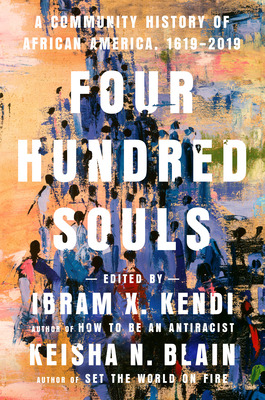
Juneteenth: Nonfiction Recommendations
On Juneteenth by Annette Gordon-Reed
Weaving together American history, dramatic family chronicle, and searing episodes of memoir, this volume provides a historian’s view of the country’s long road to Juneteenth, recounting both its origins in Texas and the enormous hardships that African-Americans have endured in the century since, from Reconstruction through Jim Crow and beyond. All too aware of the stories of cowboys, ranchers, and oilmen that have long dominated the lore of the Lone Star State, Gordon-Reed - herself a Texas native and the descendant of enslaved people brought to Texas as early as the 1820s - forges a new and profoundly truthful narrative of her home state.
A Slave No More by David W. Blight
Slave narratives are extremely rare, with only 55 post-Civil War narratives surviving. A mere handful are first-person accounts by slaves who ran away and freed themselves. Now two newly uncovered narratives join that exclusive group. Handed down through family and friends, they tell gripping stories of escape: Through a combination of intelligence, daring, and sheer luck, the men reached the protection of occupying Union troops. In the stories of Wallace Turnage and John Washington, we find portals that offer a rich new answer to the question of how four million people moved from slavery to freedom.
A Black Women’s History of the United States by Daina Ramey Berry
This volume reaches far beyond a single narrative to showcase Black women’s lives in all their fraught complexities. Berry and Gross prioritize many voices: enslaved women, freedwomen, religious leaders, artists, queer women, activists, and women who lived outside the law. The result is a starting point for exploring Black women’s history and a testament to the beauty, richness, rhythm, tragedy, heartbreak, rage, and enduring love that abounds in the spirit of Black women in communities throughout the nation.
Four Hundred Souls edited by Ibram X. Kendi & Keisha N. Blain
Curated by Ibram X. Kendi and fellow historian Keisha N. Blain, this volume begins with the arrival of twenty enslaved Ndongo people on the shores of the British colony in mainland America in 1619, the year before the arrival of the Mayflower. In eighty chronological chapters, this book charts the tragic and triumphant four-hundred-year history of Black American experience in a choral work of exceptional power and beauty.
#juneteenth#juneteenth celebration#nonfiction#nonfiction books#Nonfiction Reading#nonfiction reads#Library Books#Book Recommendations#book recs#Reading Recs#reading recommendations#TBR pile#tbr#tbrpile#to read#Want To Read#freedom to read#Booklr#book tumblr#book blog#library blog
5 notes
·
View notes
Text
Wyoming
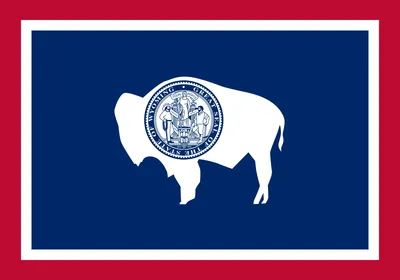
Welcome to Wyoming, the Cowboy State, where you can experience both adventure and tranquility. Wyoming is known for its wide-open spaces, where you can see the stars at night and breathe fresh air during the day. It is a state that is rich in history, culture, and natural wonders, making it a perfect destination for travelers who want to explore the wild and scenic side of the United States. Wyoming has a fascinating history that dates back thousands of years. The state was home to various Native American tribes, including the Shoshone, Arapaho, and Crow, and played an essential role in the fur trade and westward expansion during the 19th century. Wyoming became a territory in 1868 and a state in 1890, making it the 44th state in the Union. When it comes to geography, Wyoming is a stunning state that boasts diverse landscapes, including the Rocky Mountains, rolling hills, and wide-open plains. It is the ninth-largest state in the country, with a total land area of 97,818 square miles. Located in the western United States, Wyoming shares borders with Montana, South Dakota, Nebraska, Colorado, Utah, and Idaho. Wyoming is abundant in natural resources, such as coal, natural gas, and oil, which drive the state's economy. The state is also known for its tourism industry, which offers visitors a chance to explore famous national parks like Yellowstone, Grand Teton, and Devil's Tower. Wyoming has a rich culture that is influenced by western heritage, Native American traditions, and modern art and music. Whether you are interested in hiking, fishing, skiing, or just relaxing in nature, Wyoming has something to offer people of all ages and interests. In this comprehensive guide, we will explore everything you need to know about Wyoming, from its history and geography to its culture and tourism. So, pack your bags, and let's begin our journey through Wyoming! Wyoming is a state located in the western United States. It is known for its stunning natural beauty, with vast plains, majestic mountains, and iconic national parks. The state's name is derived from the Delaware Indian word "Maughwauwama," which means "large plains." Wyoming has a rich history that includes Native American tribes, fur trappers, and the Oregon Trail. The area was originally inhabited by various Native American tribes, including the Shoshone, Arapaho, and Cheyenne tribes. In the early 19th century, fur trappers ventured into the region in search of valuable pelts. The Oregon Trail, a historic wagon route, played a significant role in the westward expansion of the United States, passing through Wyoming. Geographically, Wyoming is characterized by its diverse landscapes. The state is home to the Great Plains, which stretch across the eastern part of Wyoming, offering vast open spaces and a rich agricultural heritage. In contrast, the western part of the state is dominated by the Rocky Mountains, including the iconic Grand Tetons and the Wind River Range. These mountain ranges provide breathtaking scenery and endless opportunities for outdoor recreation. One of the state's most famous attractions is Yellowstone National Park, the world's first national park. Yellowstone is renowned for its geysers, hot springs, and abundant wildlife. The park is home to iconic features such as Old Faithful, a geyser that erupts with remarkable predictability, and the Grand Prismatic Spring, a vibrant and mesmerizing natural wonder. Wyoming also boasts several other national parks and recreation areas, including Grand Teton National Park and Bighorn Canyon National Recreation Area. These protected areas offer opportunities for hiking, camping, fishing, and wildlife viewing. The state's commitment to conservation and preserving its natural habitats is evident in its efforts to protect endangered species such as the black-footed ferret and the grizzly bear. Wyoming's economy is diverse, with industries such as energy, tourism, agriculture, and mining playing significant roles. The state is a leading producer of coal, natural gas, and wind energy. Its natural beauty and outdoor recreational opportunities attract visitors from around the world, contributing to the tourism industry. Agriculture, including cattle ranching and crop production, is also an important sector of Wyoming's economy. Throughout the state, you can explore Wyoming's cultural heritage, which includes its Native American tribes and cowboy traditions. Museums, festivals, and events celebrate the state's culture and history. Famous individuals from Wyoming, such as former Vice President Dick Cheney and renowned artist Jackson Pollock, have made significant contributions to politics and the arts. Whether you're seeking outdoor adventure, cultural exploration, or simply a glimpse of the stunning natural beauty, Wyoming offers a wealth of experiences. From its majestic mountains to its vibrant plains, this state is a treasure waiting to be discovered.
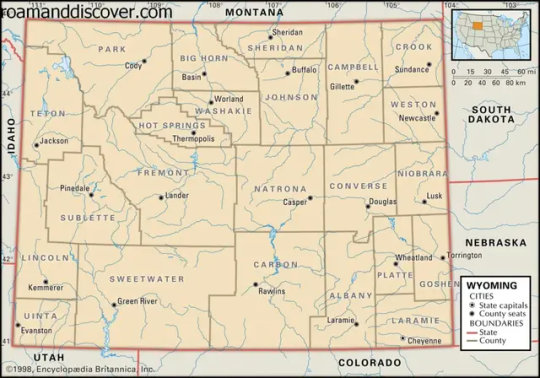
1. History of Wyoming
Wyoming, a state located in the western United States, has a fascinating history that encompasses Native American tribes, fur trappers, and the Oregon Trail. The early inhabitants of Wyoming were Native American tribes such as the Shoshone, Arapaho, and Cheyenne. These tribes have inhabited the region for thousands of years, leaving behind a rich cultural heritage. During the 19th century, Wyoming became a significant area for fur trapping, attracting explorers and traders. The fur trade played a crucial role in the state's early economy and brought European settlers to the region. However, it was the Oregon Trail that truly shaped Wyoming's development. The Oregon Trail served as a major route for pioneers heading westward during the mid-1800s, bringing thousands of settlers to the area. Wyoming's history is also intertwined with the expansion of the United States. The state witnessed conflicts between Native American tribes and the U.S. government, including the Battle of Little Bighorn, where Lakota Sioux and Cheyenne warriors defeated General George Custer's forces. Wyoming's history also includes the establishment of military outposts and the development of the transcontinental railroad, which played a crucial role in connecting the East and West coasts of the United States. Today, Wyoming's rich history is celebrated through various museums, historical sites, and events that showcase the state's cultural heritage. Visitors can explore the Oregon Trail Historic Sites, visit the Fort Laramie National Historic Site, or learn about Native American history at the Wind River Indian Reservation. Wyoming's history is a testament to the resilience and spirit of the people who have shaped the state into what it is today.
2. Geography and Climate
Wyoming, located in the western United States, boasts a diverse geography that offers breathtaking natural beauty. From the expansive Great Plains to the majestic Rocky Mountains, the state is a haven for outdoor enthusiasts and nature lovers alike. One of Wyoming's most notable geological formations is Yellowstone National Park. This iconic national park is home to mesmerizing geysers, such as the famous Old Faithful, which erupts with stunning precision. The park also features the Grand Prismatic Spring, a vibrant and captivating natural wonder with its vivid colors and unique microbial life. In addition to Yellowstone, Wyoming is also known for the Grand Tetons. These towering mountains offer awe-inspiring vistas and countless hiking trails for adventurers to explore. Whether you're an experienced hiker or a casual nature enthusiast, the Grand Tetons are sure to leave you in awe of their grandeur. When it comes to climate and weather, Wyoming experiences a range of conditions throughout the year. The state's high elevation and continental climate contribute to its distinct weather patterns. Summers are generally warm with mild temperatures, while winters can be harsh and snowy, especially in the mountainous regions. Overall, Wyoming's geography and climate offer a unique and captivating experience for visitors. Whether you're exploring the vast plains, hiking through the majestic mountains, or marveling at the geological wonders, the state's natural beauty is sure to leave a lasting impression. 2.1 Natural Wonders Wyoming is a treasure trove of natural wonders, and at the top of the list is Yellowstone National Park. Established in 1872, it holds the distinction of being the world's first national park. Spanning over 2.2 million acres, this vast wilderness is a paradise for nature lovers and adventure seekers alike. Yellowstone National Park is renowned for its mesmerizing geysers, hot springs, and bubbling mud pots. The most famous geyser in the park is the iconic Old Faithful. As its name suggests, Old Faithful erupts with remarkable predictability, shooting a column of scalding water high into the sky. Witnessing this natural spectacle is truly awe-inspiring. But the wonders of Yellowstone don't end with geysers. The park is also home to an incredible array of wildlife, including grizzly bears, wolves, elk, and bison. Exploring the park's vast network of trails, you might come across these majestic creatures in their natural habitat. Keep your camera ready for those breathtaking encounters. Aside from Yellowstone, Wyoming boasts other natural wonders that will leave you spellbound. The Grand Prismatic Spring, located in Yellowstone, is a sight to behold. Its vivid colors, ranging from deep blue to vibrant orange, are a result of the presence of heat-loving microorganisms. This kaleidoscope of hues is a testament to the wonders of nature's artistry. Whether you're a nature enthusiast, a wildlife lover, or simply seeking adventure, Wyoming's natural wonders will captivate your senses and leave you with memories that will last a lifetime. 2.1.1 Old Faithful One of the most famous attractions in Yellowstone is the Old Faithful geyser. This natural wonder has captivated visitors for decades with its predictable eruptions and stunning displays of power. But what makes Old Faithful so reliable? The science behind Old Faithful's eruptions lies in its unique geological features. Deep beneath the Earth's surface, there is a reservoir of superheated water. As this water rises to the surface, it encounters a narrow and constricted channel known as the geyser's plumbing system. This channel acts as a natural pressure cooker, trapping the water and steam until the pressure becomes too great, causing the geyser to erupt. Unlike other geysers, Old Faithful has a remarkably consistent eruption pattern. It erupts approximately every 90 minutes, shooting water and steam up to 180 feet in the air. This predictability is what earned it the name "Old Faithful." Early explorers and settlers in the area were amazed by its reliability, and it became a popular destination for tourists. Today, visitors from around the world gather around Old Faithful, eagerly awaiting its next eruption. The geyser's eruptions are not only a spectacle to behold but also a reminder of the incredible forces at work beneath the Earth's surface. It serves as a testament to the dynamic nature of Yellowstone National Park and the wonders of nature. 2.1.2 Grand Prismatic Spring The Grand Prismatic Spring is a natural wonder that never fails to mesmerize visitors with its vibrant colors and unique microbial life. Located in Yellowstone National Park, this spring is a sight to behold. The striking hues of blue, green, yellow, and orange create a stunning visual display that is truly breathtaking. But what makes the Grand Prismatic Spring so colorful? The answer lies in the geological processes that occur beneath the surface. This spring is a hot spring, which means that it is heated by geothermal energy from the Earth's interior. As the hot water rises to the surface, it brings with it minerals and microorganisms. The vibrant colors of the Grand Prismatic Spring are a result of these microorganisms. The water contains different types of bacteria and algae, each thriving in different temperature zones. The colors are a reflection of the specific temperature conditions and the pigments produced by the microorganisms. The outer edges of the spring are cooler, creating an environment suitable for orange and yellow bacteria. As the water gets hotter towards the center, it becomes ideal for green and brown bacteria. The combination of these different colors creates the mesmerizing rainbow-like effect that is characteristic of the Grand Prismatic Spring. In addition to its stunning colors, the Grand Prismatic Spring is also home to a unique microbial ecosystem. The microorganisms living in the spring play a crucial role in the ecosystem by converting the mineral-rich water into organic matter. This process supports the growth of other organisms, such as insects and birds, creating a delicate balance of life. Visiting the Grand Prismatic Spring is a truly awe-inspiring experience. As you walk along the boardwalk that surrounds the spring, you can witness the beauty of nature's artistry up close. The vibrant colors, the steam rising from the water, and the sound of bubbling geothermal activity all combine to create a sensory feast. So, if you ever find yourself in Wyoming, make sure to visit the Grand Prismatic Spring. It is a testament to the wonders of the natural world and a reminder of the incredible geological processes that shape our planet. 2.2 Mountain Ranges Wyoming is blessed with the presence of several breathtaking mountain ranges, making it a paradise for outdoor enthusiasts and nature lovers. Two of the most prominent mountain ranges in the state are the Grand Tetons and the Wind River Range. These majestic peaks offer not only awe-inspiring beauty but also a plethora of recreational opportunities. The Grand Tetons, located in the northwestern part of Wyoming, are a sight to behold. Rising abruptly from the surrounding plains, these rugged peaks create a dramatic backdrop for the picturesque Jackson Hole valley. Hiking enthusiasts can explore a network of trails that traverse the mountains, offering stunning vistas and the chance to spot wildlife such as elk, moose, and even grizzly bears. The Grand Tetons also provide excellent opportunities for rock climbing, with their challenging granite faces attracting climbers from all over the world. The Wind River Range, located in western Wyoming, is another mountain paradise waiting to be discovered. Spanning over 100 miles, this range is home to more than 40 peaks exceeding 13,000 feet in elevation, including Wyoming's highest point, Gannett Peak. Hikers and backpackers can embark on multi-day adventures through the Wind River Range, exploring pristine alpine lakes, cascading waterfalls, and lush meadows. The range also offers world-class fishing opportunities, with its numerous lakes and rivers teeming with trout. In addition to hiking and fishing, these mountain ranges provide a playground for a wide range of outdoor activities. Mountain biking, horseback riding, and camping are popular pursuits in both the Grand Tetons and the Wind River Range. During the winter months, snow enthusiasts can enjoy skiing, snowboarding, and snowshoeing in the snowy wonderland of these mountains. Whether you are seeking solitude and serenity or adrenaline-pumping adventures, the mountain ranges of Wyoming have something for everyone. So lace up your hiking boots, pack your fishing rod, and get ready to immerse yourself in the natural beauty and endless possibilities of the Grand Tetons and the Wind River Range.
3. Wildlife and Conservation
Wyoming is a paradise for wildlife enthusiasts, offering a diverse range of species and habitats. The state is home to iconic animals such as bison, elk, wolves, and bears, making it a haven for nature lovers and wildlife photographers. From the vast open plains to the rugged mountain ranges, Wyoming's natural landscapes provide a perfect habitat for these magnificent creatures. Conservation efforts play a crucial role in preserving Wyoming's rich biodiversity. The state recognizes the importance of protecting its natural habitats and has implemented various initiatives to ensure the survival of its wildlife. These efforts include the establishment of protected areas, such as national parks and wildlife refuges, where animals can thrive undisturbed. Yellowstone National Park, located primarily in Wyoming, is a prime example of successful conservation. It is not only home to a diverse range of wildlife but also serves as a sanctuary for endangered species. The park's unique ecosystem, which includes geothermal features and abundant food sources, supports a thriving population of animals. Preserving Wyoming's natural habitats is not only essential for the survival of its wildlife but also for maintaining the ecological balance. The state's diverse ecosystems provide crucial services, such as water filtration, carbon sequestration, and pollination, which are vital for human well-being. By protecting Wyoming's natural habitats, we ensure that future generations can continue to enjoy the beauty and wonder of its wildlife. It is our responsibility to be good stewards of the land and to support conservation efforts that safeguard the state's natural heritage. So, whether you're a wildlife enthusiast, a nature lover, or simply someone who appreciates the beauty of the natural world, Wyoming is a destination that should be on your bucket list. Explore its stunning landscapes, encounter its diverse wildlife, and witness firsthand the importance of conservation in preserving our planet's precious resources.

Bison 3.1 Yellowstone National Park Yellowstone National Park is a world-renowned natural wonder located primarily in Wyoming, but also extending into Montana and Idaho. Established in 1872, it holds the distinction of being the first national park in the United States and is widely considered the birthplace of the national park system. What makes Yellowstone truly remarkable is its unique ecosystem, which is home to a diverse range of plant and animal species. The park boasts an incredible array of wildlife, including grizzly bears, wolves, elk, bison, and many others. Visitors to Yellowstone have the opportunity to witness these magnificent creatures in their natural habitat, making it a sanctuary for both wildlife and nature enthusiasts. The park's ecosystem is shaped by various natural features, such as the famous geysers and hot springs. The most iconic of these is the legendary Old Faithful geyser, which erupts with remarkable regularity, captivating visitors with its spectacular displays. Other notable geothermal features include the Grand Prismatic Spring, known for its vibrant colors and unique microbial life. However, Yellowstone National Park also faces numerous challenges. One of the primary concerns is the delicate balance of its ecosystem. The park's wildlife populations must be carefully managed to ensure their long-term survival. Additionally, the park grapples with issues such as invasive species, habitat degradation, and the impact of climate change. Read the full article
2 notes
·
View notes
Text
The Timeless Appeal of Stetson Leather Hats: Style Tips and Tricks

Introduction
Stetson leather hats have long been a symbol of classic American style, offering both durability and elegance. Falcon Suede USA proudly presents a range of Stetson leather hats that cater to fashion enthusiasts and practical wearers alike. In this blog, we’ll explore the timeless appeal of Stetson leather hats, along with some style tips and tricks to help you make the most of this iconic accessory.
The History and Legacy of Stetson Leather Hats
Stetson hats have a rich history dating back to the late 19th century. Founded by John B. Stetson in 1865, the brand quickly became synonymous with the rugged American West. Cowboys, ranchers, and outdoor enthusiasts embraced the hats for their durability and style. Today, Stetson continues to uphold its legacy, offering high-quality leather hats that combine traditional craftsmanship with modern fashion.
Why Stetson Leather Hats Are Timeless
Stetson leather hats have stood the test of time for several reasons:
Quality Craftsmanship: Each hat is meticulously crafted using premium leather, ensuring longevity and durability.
Versatile Style: Stetson hats can be paired with a wide range of outfits, from casual jeans to formal suits, making them a versatile addition to any wardrobe.
Classic Design: The timeless design of Stetson hats transcends trends, allowing them to remain fashionable year after year.
Practicality: These hats offer excellent sun protection and are perfect for various outdoor activities, from hiking to horseback riding.
Style Tips for Stetson Leather Hats
Styling a Stetson leather hat can be both fun and straightforward. Here are some tips to help you create the perfect look:
Casual Chic: Pair your Stetson hat with a simple t-shirt, denim jeans, and boots for a laid-back, stylish look.
Western Flair: Embrace the Western heritage of Stetson hats by wearing them with a plaid shirt, jeans, and cowboy boots.
Urban Sophistication: Combine your hat with a sleek leather jacket and dark jeans for an urban, edgy vibe.
Summer Style: For a relaxed summer look, wear your Stetson hat with a linen shirt and chinos.
Tricks to Keep Your Stetson Leather Hat Looking New
Maintaining your Stetson leather hat is essential to preserve its appearance and longevity. Here are some maintenance tips:
Regular Cleaning: Gently brush off dust and dirt with a soft brush. For deeper cleaning, use a damp cloth and mild soap.
Proper Storage: Store your hat in a cool, dry place. Use a hat stand or keep it in a hat box to maintain its shape.
Avoid Moisture: Keep your hat away from excessive moisture. If it gets wet, allow it to air dry naturally.
Leather Conditioner: Apply a leather conditioner periodically to keep the leather soft and supple.
How to Choose the Perfect Stetson Hat
Choosing the right Stetson hat involves considering several factors:
Fit: Ensure the hat fits comfortably on your head. It should be snug but not too tight.
Style: Select a style that complements your wardrobe and personal taste.
Color: Choose a color that matches your outfit and skin tone. Classic colors like brown and black are versatile options.
Occasion: Consider the occasions you’ll be wearing the hat for. A more formal hat may be suitable for special events, while a casual hat is ideal for everyday wear.
Where to Buy Stetson Leather Hats
You can purchase Stetson leather hats directly from the Falcon Suede USA website. They offer a seamless shopping experience with detailed product descriptions and images to help you make an informed decision. Look out for seasonal discounts and promotions to get the best deals on these iconic hats.
Conclusion
Stetson leather hats from Falcon Suede USA are a timeless accessory that adds a touch of classic elegance to any outfit. Whether you’re looking for a versatile hat for everyday wear or a stylish piece for special occasions, Stetson hats are an excellent choice. Embrace the rich history and superior craftsmanship of these hats, and make a lasting impression wherever you go.
0 notes
Text
django unchained: 4.5/5
GODDDD THIS MOVIE IS SO GOOD. SO GOOD.
tonight i watched django unchained! my pc is having issues and i can't edit properly so to pass the time i decided to finally get this movie out of the way as my friend has been recommending it to me for forever. from the get go i knew i was gonna be interested in this movie considering it's (i don't know to what extent, i'm not a history expert nor american so idk) historically accurate and i loooveeee a historically based movie ^__^

obviously it's a quentin tarantino movie, it's gonna Look Good. i have once again been pulled in by the magic pretty colors and how well they all contrast together, and i love a lot of the choices they made for the shots. a lot of quick zoom ins, panning out stuff, very good. those choices specifically made it feel more and more like an authentic western movie since it gave a feel of those older cowboy movies. this shot specifically of the blood splattering onto the cotton plants was SOOOOOO ugh. amazing. love.

i didn't expect this movie to be this gory for some reason? but it's to a point i can tolerate, it's a lot of fast shooting kind of gore rather than the kind of gore that's slow and painful so it was fun to watch. it wasn't an ewwwwwww kind of gore it was fun!

unfortunately leonardo dicaprio once again does well acting. god do i wish he was bad. as a person? absolutely, you don't date freshly turned 18 year olds and be a good person. but man can he pull off playing a rich asshole well. stuck up and racist, he probably fits off half of that anyways.
jamie foxx does very well in this movie too, sometimes though it did feel a little too much like he was trying to act cool but i think it's also what they were going for? they weren't exactly trying to play a lot of these characters off as the most accurate to real people, it did feel exaggerated but in a way that was enjoyable and not cheesy. i also do wish carrie washington had more lines, i think it would've been fun to see her talk and interact more and not just be a damsel in distress. definitely does not pass the bechdel test, that's for sure.

also i really enjoyed the music score and soundtrack!!!!! i really enjoyed whenever they embedded actual rap songs into the soundtrack and not have it be purely just cowboy southern style music. it reflects the struggle of black americans not only from the past but how it evolved over time, additionally it was a choice that clarified to the audience that it's a modern adaptation of a cowboy movie.
overall for this movie, i have the same kind of high i got off of watching babylon. beautifully shot, very well played out storyline, at times somewhat chaotic? yes. but i think in this movie specifically, they were able to know when things need to slow down and when it needs to be hyped up and exciting. i had lots of fun watching!!! <3

0 notes
Text
Beyond the Rodeo: Beyoncé's Cowboy Carter Unveils a New Frontier in Music
Rating 8/10 - GREAT Album Beyoncé's new album, Cowboy Carter, marks a significant evolution in her illustrious career, blending a rich tapestry of musical genres with country music at its core. Over five years in the making, Beyoncé embarked on the project in 2019, finding creative fervor during the COVID-19 pandemic. This album, which is a part of a trilogy aimed at exploring the Black roots of various musical genres, follows Renaissance (2022), a celebration of house and disco music. One of Beyoncé's inspirations for Cowboy Carter comes from the history of Black cowboys, an aspect of Western history and culture she felt was overlooked and deserved to be highlighted. This theme resonates with her personal experiences growing up in Houston and attending the Houston rodeo, reflecting a desire to reclaim and celebrate the place of Black performers in the narrative of the American West. Musically, Cowboy Carter is a country album that intricately weaves in elements of blues, soul, rock, R&B, zydeco, folk, bluegrass, opera, go-go, flamenco, and fado, showcasing Beyoncé's ability to blend genres seamlessly. The album also features a unique concept where it's presented as a broadcast from a fictional Texas radio station, with country legends like Dolly Parton, Linda Martell, and Willie Nelson acting as radio DJs. This innovative approach is complemented by collaborations with a range of artists, including rising country musicians and established stars like Stevie Wonder, Nile Rodgers, and Jon Batiste. One of the album's standout moments includes a cover of The Beatles “Blackbird” and Dolly Parton's "Jolene," a song Parton herself expressed a desire to hear Beyoncé perform. The inclusion of this cover, alongside original tracks that pay homage to the likes of Linda Martell, signifies Beyoncé's respect and acknowledgment of country music's heritage and its diverse influences. In terms of promotion, the album was teased during Super Bowl LVIII in a commercial that played with the idea of breaking the internet with increasingly extravagant stunts, culminating in the announcement of new music. This was followed by a visually striking teaser video directed by Nadia Lee Cohen, which paid homage to Paris, Texas and featured Chuck Berry's "Maybellene." Beyoncé has described Cowboy Carter as not just a country album but a "Beyoncé album," underscoring her intent to challenge genre limitations and create a body of work that transcends traditional musical boundaries. This ambition is reflected in the album's cyclical structure, echoing the endless loop of storytelling found in James Joyce's Finnegans Wake, and in Beyoncé's dedication to using her music to unite people and amplify important voices in musical history. Check out “Blackbird” below: Read the full article
0 notes
Text
"Walking Tall: Leather Wingdom's Impeccable Men's Duster Coats"
In the world of men's fashion, certain garments possess a timeless appeal that transcends trends and seasons. Among these enduring classics, the men's duster coat stands tall as an iconic piece that has not only retained its practicality but has also become a symbol of rugged elegance. In this article, we'll explore the fascinating world of Leather Wingdom's impeccable men's duster coats and discover why they continue to be a staple in contemporary men's wardrobes.

A Brief History of Duster Coats
Duster coats, originally designed as practical workwear for horsemen in the late 19th century, have come a long way from their utilitarian origins. These long, lightweight coats were initially intended to protect riders from the dust and debris kicked up by their horses during long journeys. Over time, duster coats found their way into the closets of cowboys, ranchers, and adventurers, becoming synonymous with the spirit of the American West.
The Resurgence of Duster Coats
In recent years, duster coats have experienced a resurgence in popularity, thanks to their timeless style and versatility. One company that has been at the forefront of this revival is Leather Wingdom, a renowned name in the world of men's outerwear. Leather Wingdom has taken the classic duster coat and given it a modern twist, making it a must-have item for the contemporary man.
Quality Craftsmanship
Leather Wingdom's commitment to quality craftsmanship is evident in every one of their men's duster coats. These coats are made from premium materials, with a keen attention to detail. Whether it's the softness of the leather, the precision of the stitching, or the durability of the hardware, Leather Wingdom spares no expense in ensuring that their duster coats meet the highest standards.
Style Meets Functionality
One of the standout features of Leather Wingdom's duster coats is their seamless blend of style and functionality. While these coats pay homage to their rugged roots, they are equally at home in urban settings. The versatile design allows them to be dressed up or down, making them suitable for a wide range of occasions.
A Range of Options
Leather Wingdom offers a diverse range of men's duster coats to cater to various tastes and preferences. From classic brown leather dusters that evoke the spirit of the Wild West to sleek black options that exude urban sophistication, there's a Leather Wingdom duster for every style sensibility. Different lengths and cuts are also available, allowing customers to choose the perfect fit for their unique look.
The Legacy Continues
The enduring appeal of Leather Wingdom's impeccable men's duster coats can be attributed to their ability to blend history with modernity. These coats pay homage to a rich heritage while remaining relevant in the fast-paced world of fashion. Whether you're a seasoned adventurer or simply appreciate the elegance of a well-crafted coat, Leather Wingdom's dusters offer a touch of class that never goes out of style.
Conclusion
In a world where fashion trends come and go, Leather Wingdom's men's duster coats stand as a testament to the enduring appeal of classic style and quality craftsmanship. These coats not only protect against the elements but also make a bold statement about the wearer's commitment to timeless fashion. So, if you're looking for a garment that exudes rugged elegance and tells a story of American heritage, look no further than Leather Wingdom's impeccable men's duster coats. Walk tall, wear a duster, and make a statement that will never go out of fashion.
0 notes
Photo

REVIEW
Black Rodeo by Mia Mask
A History of the African American Western
Erudite, informative, interesting, and easy to read professional look at the history of African American cinematic Westerns spanning over a century of cinematic treasures. The book provides synopses of the movies chosen, the political and historical inferences that might be made, and introduces the directors and actors starring in them.
What I liked:
* Bill Pickett: first African American cowboy film star born in the 1800’s
* Learning details about the Western film genre and how it changed over time
* Terms used in discussing the genre that I had not thought about in terms of Westerns and skin color: revisionist, post western, sauerkraut & spaghetti westerns, antithesis, exploitative, politicizing, blaxploitation, black liberation, westploitation, miscegenation,
* Learning how censoring at times impacted the stories allowed to be told in film
* Learning about the actors in this book, how they became involved in the profession, and remembering some that I have seen in films
* Learning about the underlying inferences that can be found within the stories the films tell
* The discussion of the “N-word”
* Learning history that I did not know before and wondering if people will ever learn from the past and implement more positive outlooks and behavior in the future
What I didn’t like:
* Thinking about the negative stereotypes and history mentioned in this book, especially thinking about the story that the movie Rosewood was based on.
Did I enjoy this book? Yes
Thank you to NetGalley and University of Illinois Press for the ARC – this is my honest review.
5 Stars
BLURB
African American westerns have a rich cinematic history and visual culture. Mia Mask examines the African American western hero within the larger context of film history by considering how Black westerns evolved and approached wide-ranging goals. Woody Strode’s 1950s transformation from football star to actor was the harbinger of hard-edged western heroes later played by Jim Brown and Fred Williamson. Sidney Poitier’s Buck and the Preacher provided a narrative helmed by a groundbreaking African American director and offered unconventionally rich roles for women. Mask moves from these discussions to consider blaxploitation westerns and an analysis of Jeff Kanew’s hard-to-find 1972 documentary about an all-Black rodeo. The book addresses how these movies set the stage for modern-day westploitation films like Django Unchained.
A first-of-its kind survey, Black Rodeo illuminates the figure of the Black cowboy while examining the intersection of African American film history and the western.
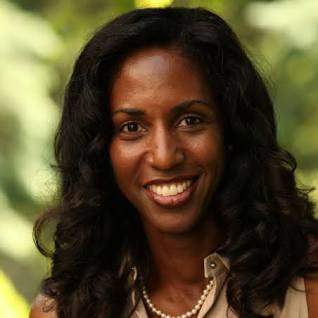
AUTHOR BIO
Mia Mask, Professor of Film, received her PhD from New York University. At Vassar College, Ms. Mask teaches African American cinema, Documentary History, seminars on special topics such as the horror film, and auteurs like Spike Lee, Charles Burnett and Ava DuVernay. She also teaches feminist film theory, African national cinemas, and genre courses. Her commentary can be heard on NPR.
Mask is the author of Divas on Screen: Black Women in American Film, published by University of Illinois Press. Divas on Screen was featured on the public radio program "Tell Me More." Formerly an assistant editor and regular contributor at Cineaste magazine, she has written film reviews and covered festivals for IndieWire.com, The Village Voice, Film Quarterly, Time Out New York, The Philadelphia Inquirer, and The Poughkeepsie Journal. Her criticism was anthologized in Best American Movie Writing. She is currently on the editorial board of The Black Scholar.
She has been a Visiting Professor of Film Studies at Yale University and University of Pennsylvania. She has twice been a visiting scholar at New York University. Her scholarly essays are published in the African American National Biography; Screen Stars of the 1990s; Film and Literature; and American Cinema of the 1970s. Mask edited Black American Cinema Reconsidered (Routledge, 2012). In 2014, she published Poitier Revisited: Reconsidering a Black Icon in the Obama Age (Bloomsbury, 2014).
Professor Mask served at the Institute of International Education as a member of the National Screening Committee assembled to select Fulbright scholars for three consecutive years.
Her cultural commentary can be heard on National Public Radio.
0 notes
Text
The Legend of Bass Reeves: The Black Cowboy Who Inspired a Generation
The Legend of Bass Reeves: The Black Cowboy Who Inspired a Generation

Bass Reeves was born into slavery in Arkansas in 1838 and spent much of his early life working on plantations. However, after the Civil War, he was given his freedom and he moved to the Indian Territory in what is now Oklahoma. In the late 1800s, he became a U.S. Marshal, and his exceptional skills as a lawman quickly made him one of the most respected law enforcement officers of his time.
Reeves became a lawman after he was appointed as a deputy U.S. Marshal by Judge Isaac Parker, who was known for his harsh sentences in the Indian Territory. Judge Parker chose Reeves for his exceptional skills as a marksman and his knowledge of the territory, as well as his ability to speak several Native American languages fluently. In addition, Reeves was known for his courage and integrity, which made him well-respected among both white settlers and Native American communities.
Throughout his 32-year career, Reeves arrested more than 3,000 felons, including some of the most notorious outlaws of the Wild West. He was known for his ability to track down fugitives, using his extensive knowledge of the territory and his ability to blend in with the local populations. He was also known for his unwavering dedication to justice, even in the face of danger, and his reputation as a fair and impartial lawman.

It's no secret that the "Lone Ranger" was heavily influenced by the real-life stories of figures like Bass Reeves. The character, first introduced in a 1933 radio series, embodies many of the traits that made Reeves such a remarkable figure, including his e

Despite this, the character is portrayed as a white man and never mentions or references Reeves, despite the fact that the two are inextricably linked in the annals of Western folklore.
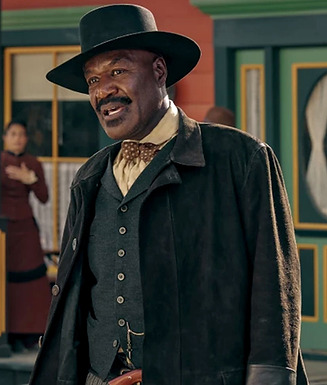

my current independent video game project
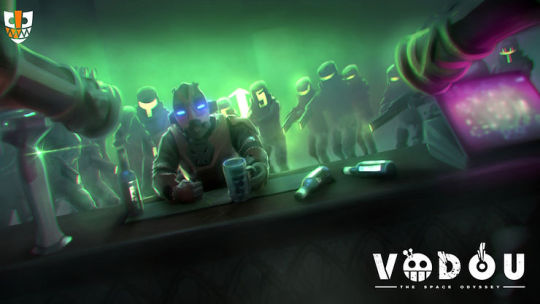
For young Africans in Nigeria and other countries, hearing about Bass Reeves and his legacy is an inspiring reminder of the power of the human spirit to overcome adversity and make a lasting impact on the world.
But the story of Bass Reeves is not just a source of inspiration for young people. It is also a valuable reminder of the rich and complex history of black Americans, who have made countless contributions to the building of this nation, despite the many obstacles they have faced along the way.
As we move forward into a new era of black empowerment, it is more important than ever to remember and celebrate the heroes of our past. Bass Reeves is one of these heroes, and his story is a testament to the resilience, courage, and determination that have been hallmarks of the black experience in America.
So, let us remember Bass Reeves this Black History Month and celebrate the legacy of this true American hero, who made a lasting impact on the Wild West and the nation as a whole. So, let us remember Bass Reeves this Black History Month and celebrate the legacy of this true American hero, who made a lasting impact on the Wild West and the nation as a whole. www.jujugames.net
1 note
·
View note
Text
"Democrats [party of the confederacy] got as much traction as they did in part because they contrasted what they saw as a system of race-based wealth redistribution taking hold in the East with an image of the American West where hardworking men asked nothing of the government but to be left alone."
"The cowboy era and Reconstruction overlapped almost exactly, and to oppose Republican policies, Democrats mythologized the cowboy, self-reliant and tough, making his way in the world on his own. Cowboy life was actually harsh and decidedly unromantic, but that didn't matter to those seeking to use the cowboy's image to undermine the growing federal government"
-Heather Cox Richardson, How the South Won the Civil War
"The system they saw" was the General of the Union being elected President. He, unlike the man who took office when Lincoln was shot, passed the Fourteen Amendment to give Black men the right to legally own property, sue, and testify in court. He also established martial law in places where the KKK were interfering with Black men voting, holding office, and sitting on a jury.
So the confederate Democrats, who got their pardons issued by a president who was not elected to that office, opposed reconstruction by changing tactics, instead of opposing racial equality, they'd defund it.
They started to argue that people who do not own property or wealth should not have a say in how their money is taxed, and they don't owe the government money to support the "lazy" laborers. They said any man can make it in America if they apply themself, so if you don't own much, that's your own fault. They're making their money off of share croppers and then turning around and saying their own laborers don't work hard.
The mythology of the cowboy and the gold rush was crafted by slavers to convince their voters that the ideal American citizen would vote against taxes. They didn't want policies that funded enforced fair treatment of workers, and the labor they were employed to do: build schools, hospitals, and roads in the south.
They said these taxes were an attack! They said the lazy, ignorant people of the south who plow the fields, who will never amount to anything in terms of wealth want our money because they won't raise that money themselves! It's not fair, they said. The very same people who fought a war destroying southern infrastructure didn't want to foot the bill for reconstruction.
It's incredible how long these lies have endured in American culture. I've heard these same arguments being made over taxes and how unfair it is for the rich to pay taxes, repeatedly, 200 years later, without the history they came from. It's so clear how racist, greedy, and evil it is in the original context.
0 notes
Photo
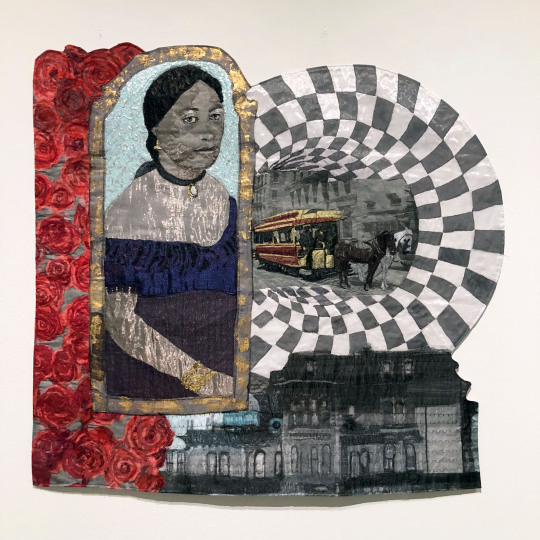
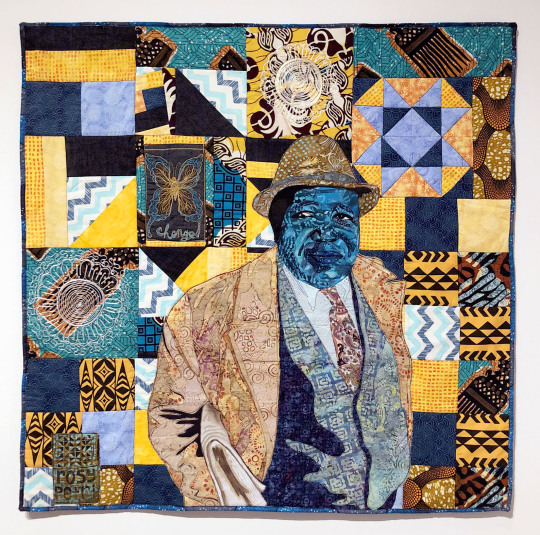
Pictured above- Call Me Mrs. Mary E. Pleasant: The Midas Touch by L'Merchie Frazier- a portrait of entrepreneur, civil rights activist and benefactor, Mary Ellen Pleasant who made a name and a fortune for herself in Gold Rush era San Francisco. Her timeline from 1814 to 1904 begins in racial slavery as an indentured servant girl with no formal education. She ascended to a self-made millionaire, amassing a fortune in her lifetime of over $30 million, ($900 million today).
The second image is A Good Soldier: Thomas C. Fleming, America's Longest Serving Black Journalist by Rosy Petri- At the time of his retirement in 1997, California journalist Thomas C. Fleming was the nation's oldest Black journalist with the longest consecutive period of publication.
Both of these quilts are from Black Pioneers: Legacy in the American West at The James Museum of Western and Wildlife Art. Organized by historian, artist, and curator Dr. Carolyn Mazloomi, it includes 50 pictorial quilts created by members of Women of Color Quilters Network, a group founded by Mazloomi in 1985.
Mazloomi's statement at the exhibition entrance-
American history is incomplete without the stories of African American men and women, from our enslaved ancestors to our societal challenges. The role of African Americans in the movement toward westward expansion has been largely overlooked. This exhibition of original pictorial quilts brings into focus the rich and diverse stories and achievements of Blacks in American western history. The timeline begins with Esteban's 1528 arrival in the West and continues through the Civil Rights Movement.
At the end of Reconstruction in the South, discrimination and segregation caused African Americans to seek opportunities where there was less prejudice. In the 1800s, they moved by the thousands to the American West. Some went West as slaves, while free African American men joined the United States Army or became ranch hands, fur traders, cowboys, or miners.
Why quilts? Quilts and quilt making are important to American, and Black culture in particular. The art form was historically one of the few mediums accessible to marginalized groups to tell their own story, to provide warmth for their families, and to empower them with a voice through cloth. Using quilts to tell these stories accentuates the intersections of African Americans in the Western frontier while at once informing about the art form and its role in Black history. It is this often unknown and underappreciated shared reality that must be voiced if we are ever to truly value the unique contributions diverse groups make to the fabric of our nation.
The impressive quilts on view educate viewers with stories of individuals and events in African American history that may not have previously been familiar, and present new perspectives on those that are. It's a wonderful way to utilize a visual medium to captivate, inform, and often inspire.
This exhibition closes on 1/8/2023.
#the james museum#dr. carolyn mazloomi#women of color quilters network#quilts#fiber arts#l'merchie frazier#rosy petri#black history#black pioneers#art#florida art shows#st pete art shows#art shows#quilt art#mary ellen pleasant#thomas c fleming
6 notes
·
View notes